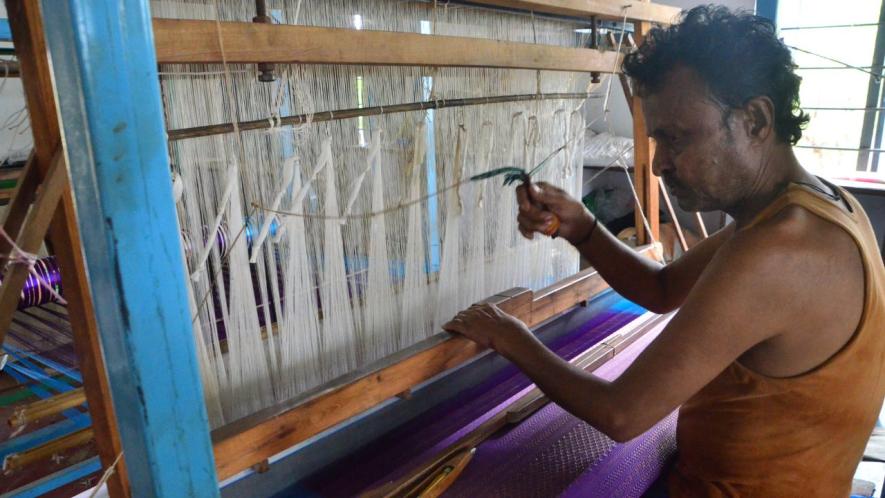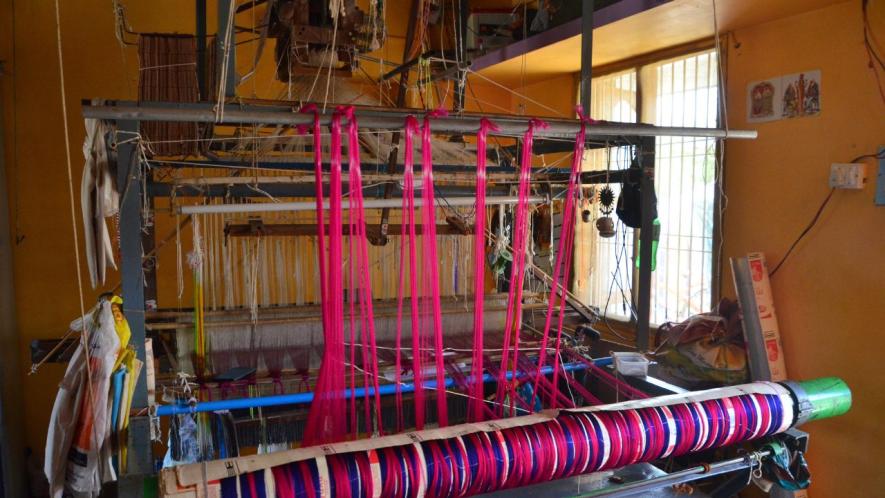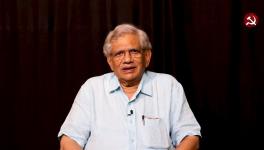World Handloom Day: In Search of the Kollegala Saree

Never before have we lived in a time when the demand worldwide for handloom and handmade has been so high and the condition of weavers and artisans so poor that most of them have left the profession in order to survive. With the 10th World Handloom Day being celebrated on August 7, none of this glory and celebration has reached the weavers. We decided to visit the silk weaving clusters of Kollegala and Hanur in Chamarajanagar district to understand their issues and witness their work first-hand.
Handloom today has become an exclusive fabric used by designers from India, Japan, Europe and mainly used for wedding attire. People are ready to pay a premium for authentic handwoven textiles.
At a time when there is a new found interest in the various traditional handloom weaves of Karnataka, such as Ilkal, Molakalmuru and Guledgudda Khana, we seldom hear about the Kollegala saree. Yet, this place boasted of a tradition of unique soft pure silk handwoven sarees in the past.
“There are no samples remaining, my father used to weave them,” said Mahesh, a young weaver when asked about the traditional designs. He remembered them as a simple plain saree with a zari border; now the sarees woven here were catering to the Tamil Nadu market and were of elaborate designs using Jacquard fitted looms.
Kollegala belonged to the Coimbatore province till 1956, after which it was included in Karnataka. Due to its proximity to the Tamil Nadu border as well as its history, the weavers here worked for the master weavers in Sathyamangalam.
“We often find our sarees packaged and branded as Kanchipuram sarees,” Mahesh said with a smile.
What we saw was that the weavers in Kollegala did not have any designs of their own. Their designs were provided by the master weavers and showroom owners in Sathyamangalam. “There are no master weavers in Kollegala,” Mahesh told us, adding that the dyeing of the silk yarn was also done in Sathyamangalam. The weavers here worked with dyed yarn, which they processed at a yarn twisting unit to create double ply yarn. The warp for the sarees was locally prepared.
We visited the automated yarn twisting unit operated by six women. Once a major producer of handwoven fabric, Kollegala now had a few scattered units across the town. We were visiting the Society that Mahesh was part of on Devangapete road, the Kollegala Kaimagga Nekara Utpadana mattu Maarata Co-operative Society. The society had a small office in the same area and consisted of 40 members.
There was no Common Facility Centre (CFCs) where the weavers came to work together. Instead, Mahesh took us to a house where there were six looms which were rented out to society weavers as well as the government-owned Karnataka Handloom Development Corporation (KHDC) weavers. The government scheme, which gave a 90% subsidy to purchase looms, was helpful to these weavers, he said.
Manohar was another weaver we met at the rented working place. He was weaving a saree that would take him five days to complete.
“I can complete it in fewer days if I could get some help with the pre-loom work, like bobbin winding, warping and such. If I was working from home, I would have my wife to help me, but here I have to do everything on my own and that takes time,” he said. When asked about his wife, he said she worked elsewhere to make enough money to run their family.
Depending on the design, Manohar said he earned Rs.2,300 to Rs.2,800 per saree which took him five days to complete, putting his daily earnings at around Rs.500. “It is hard work, but it is also the only work I know,” he said, reflecting the sentiment of the multitude of weavers today.
A short drive away from the city of Kollegala, on the Malai Mahadeshwara Betta Road, is the small town of Hanur. From the dusty bus stand, a narrow mud road took us deeper into the village. Venkatesh, an enterprising weaver, whom we had contacted through phone, met us here and led us to the weavers' homes.
Hanur had none of the amenities that the neighbouring Kollegala boasted of; it felt like a place that missed the development bus. The weavers here, although catering to the Tamil Nadu market, were more desperate and in need of better opportunities.
“There were more than 300 families of weavers here, now you will find 30 at most,” said Venkatesh. as he guided us to his own humble dwelling. His loom sat there in a corner, silently watching us, as we spoke about the problem of lack of good remuneration for the weavers.
“My sons are both working in other cities and earning well; I did not teach them weaving as my father had taught me. This is no more a lucrative profession like it was in his days,” he lamented. Yet, his passion for weaving made him stay in his village and teach this skill to others who were interested to learn from him.
While we sat at his home sipping water, he said he had trained many people locally and they weave better than him today. There was a melancholic love-hate relationship he shared with weaving; he was both proud of his family profession as well as sad about the financial state of weavers today. The low wages made it impossible to survive.
According to Venkatesh, there was a good demand for these sarees, but he felt that the money was not reaching the weavers. He was hopeful that if there were better markets for their sarees, they could be paid more. It was evident that Hanur, being a little away from any major cities, was not getting as much focus as Kollegala.
“In the past few months, there has been a dearth of work. Even during the covid lockdown, we were doing better than this. Now the showroom owners are saying that the business is down,” he recollected. Venkatesh was weaving sarees as well as yardage of plain pure silk.
At a short distance from his home, we were ushered into a low roofed modest house where Sunitha and Rangaswamy resided. Their loom, centrally located, took up most of the space in their living room. Spreading a carpet on the floor in the narrow gap between the loom and the wall, they displayed some of their best work. These sarees, each of them costing anywhere between Rs 8,000-10,000, would be sold in showrooms in Tamil Nadu for at least three times more. They were a middle-aged, enterprising couple, who explained that they worked for owners in Sathyamangalam, who gave them the raw material and design and would take the finished sarees.
Rangaswamy said he could weave up to two sarees a week, fetching them Rs 3,000 per saree. Together, with Sunita helping with the pre-loom work and Rangaswamy weaving, they were confident of completing 8 to 10 sarees in a month.
When asked if they would be given as much work as they needed, Sunita said, “They are ready to give us more; but we can only do so much in a month as each saree is intricate and takes at least three days to finish.”
Another weaver, Ramaswamy, who was weaving since his childhood, recollected that this was the only profession that he knew. But he ensured that his children were educated and would not take up the profession. When asked about the reason for this he explained, “These days, it is very difficult to find brides for our sons. Nobody wants to get their daughters married to weavers. A weaver’s wife has so much work to do, helping her husband with the loom activities as well as do the household work. The remuneration is also very low, so even if I had a daughter, I would not give her to a weaver.”

This was something we would hear everywhere we went, as though, all of a sudden, everyone everywhere had collectively taken this decision at the same time. The weavers in Hanur were dependent on the master weavers and design makers in Sathyamangalam, Mettupalayam area. They would only do the warping and weaving. Dyed yarn would come by bus to them and finished sarees would be returned. The designs, colours would all be decided elsewhere. The weavers here were used to this. To provide them new work would mean providing them the Jacquard designs as well.
We went to meet a middle-aged weaver Sudhakar next. He was weaving a Kotanchu saree with a complicated double-sided border design. He said this was in demand and it required good skill to weave. It was time consuming and he would take around a week to complete one saree. He said that he could weave faster, but he was afraid that the orders were not as forthcoming as he would have liked.
“They are asking me to stretch this for a week. They say that the business is down and they cannot provide more raw material,” he said, adding that if he would get work more regularly, it would help improve his financial situation.
Without regular orders and decent wages that recognise the skill and the effort needed to work with their hands, the weavers continue to endure the hardships, and yet, every day they sit at the loom and perform the only task they know. The resulting fabric, which is beautiful and resilient, bears no marks on their suffering. With a little improvement in their earnings and some respect, they are happy to continue their work. But repeated disappointments and a promise-less future stares at them. Without any prospects, their next generation is not ready to continue this profession.
Venkatesh wanted to show us the Society that he created and asked us to follow him to the next village, RS Doddi, a five- minute drive from Hanur. RS Doddi also had many weaver homes and was once a bustling village with every household involved in weaving a few years ago. Now there were just a handful of homes that were keeping this profession alive.
Of these, we first visited the home of Ravi and Uma, a couple in their mid-50s who explained to us many aspects of weaving. They displayed a set of sarees as soon as we entered their home and asked us to feel it. These were the adulterated sarees with silk warp and artificial silk (rayon or artificial fiber) as weft. Ravi said that the cones for the weft were also provided by their owner and they had no choice but to weave them. According to Ravi, it was this adulteration that was the reason for the decline in the silk saree demand of late. He deduced that they started weaving these "mix" sarees about a year ago and since the past three months, the business had dropped. Uma said that these sarees were not as durable as pure silk sarees and would tear easily. Due to the poorer quality, the customers felt cheated and had lost their trust, they felt.
When we asked whether they could refuse to weave these sarees, Ravi said that they had no choice. They were tied to the owner and had to do whatever he said. Although he knew that his actions were responsible for his own decline, there was little that they could do. “If we protested, even this would stop and we would not get any work,” he said.
Meanwhile, Uma showed us some pure silk sarees as well which Ravi had woven a few months ago. She said that “many times customers get duped by the artificial silk mix sarees, which are softer and shinier than the pure silk ones. And, customers do not mind a little less priced sarees as long as they look like pure silk.” She remembered her mother's wedding saree which was a Kanchipuram saree that was not just pure silk but also contained pure zari containing gold, which she inherited and retained as her prized possession. She said that the older sarees had a value that even after they get old and after sufficient wear and tear, they can be resold at a good price.
She, too, brought up the point about weavers not getting any brides for their sons and vehemently declared that she would never give her daughter's hand in marriage to a weaver. She understood the hard, often thankless work that the weavers' wives put in to help their husbands and they do this without any payment or recognition for their work. But young girls these days are not prepared for this.
Uma also felt that the government is not doing enough to recognise the problems of weavers. “Handloom weavers do not get any subsidies or incentives as farmers do.” she said. She felt that handloom weavers should be recognised along with farmers as their work is closely tied to the farmers, the silkworm keepers and so on.
The dilapidated shed that was meant to serve as a common facility centre for the society that Venkatesh and others had started, housed the warping unit along with four looms, out of which two were functional. Venkatesh told us that the society had 250 registered members but less than 30 were actively weaving today.
The Chowdeshwari Silk Society was provided the funds initially from the government to set up a shed, a part of which they have rented out to another business to use as a godown. The buildings belonging to the society were in need of some renovations. But more than anything, it needed people who would come together and work under this roof, which Venkatesh felt had failed in the past due to differences among people.
An elderly weaver, who had seen better days, said he was still pursuing this profession as a mark of respect, even with the dwindling prospects. A middle-aged man said the Society needed urgent help and they needed regular work. “Please do something for us, we are desperate and in need of work”, they said.
More than ever before, with the climate catastrophe staring at our civilisation, with alternating periods of flood and droughts, there is a need to realise that an exploitative economy that has destroyed nature cannot take society any further. There is need to simplify lifestyles and move toward a life closer to nature.
Sustainable cottage industries, such as Khadi and handlooms, hold the key for a slower means of production which can provide employment to a large population, including women and older people, without causing large-scale pollution of natural resources. Our country still has millions of artisans who even today practice their traditional skills. Before the last few of them get wiped away, we have an urgent need to save the weavers. We need to save them, not for their sake, but to protect our own future from perishing into oblivion.
The writer is managing trustee of Desi Trust, Bengaluru, which focuses on promoting handmade and handloom products and reviving the skills and livelihood in the sector. The views are personal.
Get the latest reports & analysis with people's perspective on Protests, movements & deep analytical videos, discussions of the current affairs in your Telegram app. Subscribe to NewsClick's Telegram channel & get Real-Time updates on stories, as they get published on our website.
























